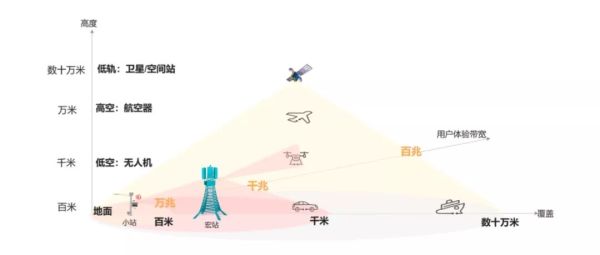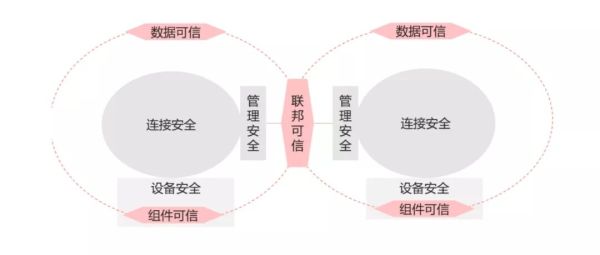What will the communication network look like in 2030?

In the past 30 years, from 2G to 5G, from ADSL to
10GPON+Wi-Fi6, from circuit switching and all-IP to all-cloud era, the
communication network has broken through the boundaries of capabilities time
and time again and achieved network speed. Thousand-fold improvement,
unprecedentedly changed people's way of life, and changed the world.
Facing the next ten years, what will the communication
network look like? Recently, Huawei released the "Smart World 2030"
report. In the simultaneous release of the "Communication Network
2030" report, six key technical characteristics are described for us. The
full picture of the communication network in 2030.

Three-dimensional ultra-wide network
Today's mobile communication network has formed a ground
broadband network with multiple scenarios and full coverage through
technologies such as Massive MIMO, uplink and downlink decoupling, as well as
the deployment of various macro stations, pole stations, micro stations, and
digital indoor distribution. It is based on such a network that the connected
objects are expanding from people to everything, and the coverage scenes are
expanding from the areas where people are active to the production environment
of all walks of life. However, this network is based on ground construction,
and the vertical coverage is generally limited to high-rise buildings in
cities. It is difficult to achieve full coverage of remote areas such as
mountains, seas, grasslands, and deserts, and it is also difficult to provide
aerial drones, aerial vehicles, and low-orbit space vehicles. Provide broadband
connection. In this regard, extending the network from the ground to the air
has become the consensus and development direction of the current industry.

In the current 5G and F5G era, in order to meet the needs of
new services such as high-definition video, VR/AR, online education, online
office, and smart home, both fixed and mobile broadband have entered the
gigabit era from the 100M era. Operators have released "three gigabit"
services one after another, that is, one gigabit for home broadband, one
gigabit for home Wi-Fi, and one gigabit for mobile phones. On the one hand,
10GGPON+Wi-Fi6 technology, coupled with FTTR networking, can provide a seamless
Gigabit experience for homes and businesses; on the other hand, the combination
of larger spectrum bandwidth and Massive MIMO technology has helped 5G networks
to achieve Gigabit speed experience. But people's demand for communication
networks is endless. How will the future network continue to evolve?
The report predicts that in the next 10 years, in order to
support new experiences such as XR, naked-eye 3D, digital touch, digital smell,
and auto-driving cars will become the "third space" outside of homes
and offices in the future, the network will grow from today's "Three
Gigabit" evolved to "30,000 Gigabit", and built a new capacity
of 10 Gigabit network integration of housing and transportation, providing
users with continuous 10 Gigabit broadband service experience from home to
travel to office. At the same time, as the broadband demand for households,
individuals, and business scenarios enters the 10 Gigabit era, in order to
carry the ever-increasing data traffic, access, metropolitan, backbone, and
data center networks will enter the T era in an all-round way.
Deterministic experience
As we all know, the biggest difference between the current
5G and 2/3/4G era is that it has changed the past "one size fits all"
and "best effort" network service model. It can provide network
bandwidth, delay, SLA-guaranteed network capabilities such as reliability and
security can provide customized and deterministic network services for
diversified businesses in different industries. At present, through end-to-end
integrated connection, cloud, edge, AI, business automatic orchestration,
ubiquitous security and other capabilities, Huawei has built a triple-leading
5G differentiated service capability with high reliability, high security, and
high SLA, and it has been implemented. Practice a large number of 5GtoB
commercial projects. But facing the next ten years, new businesses such as XR,
naked-eye 3D, digital touch and digital olfaction have higher requirements for
immersion and interactive experience, and as the network penetrates more widely
into the core production control system and all elements of the enterprise
Going to the cloud imposes more stringent requirements on network capabilities
such as latency, reliability, and security, and the network needs to further
improve its deterministic service capabilities.
In this regard, the report pointed out that in the next ten
years, the industry needs to continue to enhance the deterministic capabilities
of the network from the following three aspects: First, based on the deployment
of a wide range of distributed edge data centers, according to different
business needs, user-centered construction of backbone, The three-level delay
circle in urban agglomerations and cities can meet the different business
demands of 100ms, 10ms and 1ms, and can directly perform real-time scheduling
at the network level according to business attributes, so as to realize the
green and efficient computing power of the whole society; the second is to
continue research And enhance the end-to-end network slicing technology to
create a more adaptive logical “private network” and services for vertical
industries; third, it must be based on AI infusion, through intelligent
prediction, active resource allocation, dynamic coordination and other
mechanisms to integrate cloud network The reliability is increased to 5 9s.
Smart native
At present, as the network becomes more and more complex,
the difficulty and cost of network operation and maintenance are getting higher
and higher; and as the business becomes more and more diversified, the delay,
reliability and stability of the network due to a large number of new
applications With extremely high performance requirements and faster time for
business launches, the traditional passive manual operation and maintenance
operation model has become increasingly difficult to meet the demand. It is in
this context that it has become the consensus of the industry to promote the
mutual empowerment of networks and AI to create an autonomous, self-healing,
and self-optimizing autonomous driving network. For example, Huawei released an
autonomous driving network solution as early as 2019 to accelerate the
transformation of network digital intelligence through the introduction of
artificial intelligence technology at the device layer, network layer and cloud
full stack; China Mobile proposed for the first time in the industry this year
Reach the quantitative goal of L4 autonomous driving network by 2025.
Facing the future, the report pointed out that the
autonomous driving network will continue to evolve from the current L2~L3 level
to the L4/L5 advanced intelligence direction to enable new services and achieve
the ultimate customer experience, fully automated operation and maintenance,
and the most efficient use of resources and energy. And pointed out the key
technology research direction in the future.
On the other hand, in order to generate more emerging
applications and continuously improve the business experience, through the
integration of the network and cloud, edge computing, AI, etc., computing power
and intelligence can be injected into the entire network, providing nearby and
on-demand connections for diversified applications. Computing power has become
a recognized development trend in the industry. Facing the future, the report
also proposes the concept of edge intelligence native, that is, the network
will integrate cloud native flexibility, openness, and AI capabilities, and
reconstruct the intelligent edge to support AI-based business perception
capabilities, as well as Mesh interconnection and horizontal computing power
scheduling.
Communication perception fusion
From the 1G to 5G era, communication and perception are
independent of each other. In the 5.5G/6G era, as the communication spectrum
expands to millimeter wave, terahertz, and visible light, it overlaps with the
traditional perception spectrum, such as radars responsible for speed
measurement and inductive imaging. The system makes it possible to merge
communication and perception. As early as 2020, Huawei proposed a 5.5G vision.
Based on the current 5G scenarios of eMBB, mMTC, and URLLC, it has expanded
UCBC (upstream ultra-wideband), RTBC (real-time broadband interaction), and HCS
(communication perception integration). ) Three new scenarios to meet the needs
of the intelligent connection of all things in the next 5 to 10 years.
From the perspective of mobile communication networks, HCS
can be applied to the Internet of Vehicles and autonomous driving scenarios of
UAVs through the beam scanning technology of Massive MIMO. In the future, as
the wireless spectrum evolves in the direction of millimeter wave and terahertz
high frequency, it can also be applied to wisdom Scenes such as cities, weather
forecasts, environmental monitoring, and medical imaging. At the same time,
centimeter-level high-precision positioning will be achieved in the future,
enabling more abundant new indoor services.
In addition to the integration of communication and
perception in the field of mobile networks, the report also looks ahead to the
future development trends and technical research directions of Wi-Fi
perception, optical fiber sensing and lidar perception. In the next ten years,
Wi-Fi perception can be applied to indoor, outdoor, car, warehouse, freight
yard and other scenes, providing high-precision positioning, gesture/gesture
recognition, breathing detection, emotion recognition, perimeter security and
other functions; optical fiber sensing can Used in energy, electric power,
government, transportation and other industries, sensing changes in temperature,
vibration, and stress, providing fire monitoring and warning,
equipment/pipeline fault diagnosis, environment and facility stress monitoring,
etc.; Lidar sensing can be applied to home and car scenarios , Providing
functions such as environmental spatial perception, high-precision positioning,
gesture recognition and so on.
Safe and trustworthy
Currently, ICT technologies such as network, AI, and cloud
computing are penetrating into all walks of life to empower the digital and
intelligent transformation of the entire industry, and promote the expansion of
the industry from the consumer Internet to the industrial Internet. In the
entire industrial Internet system, the network is the foundation, the platform
is the core, security is the guarantee, and security is one of the three core
systems of the industrial Internet. In the current development of 5GtoB, we
have also seen that the industry generally attaches great importance to data
security isolation and data privacy protection, especially in industries such
as manufacturing and energy, because once a network security problem occurs, it
will affect the continuous normal production and operation of the enterprise,
and the The social economy is operating steadily.

In this regard, the report pointed out that, on the one
hand, security itself is evolving from a traditional centralized protection and
plug-in architecture to a new architecture for endogenous network security. On
the other hand, industrial interconnection will require networks to be not only
secure, but also credible. Specifically, security trustworthiness includes six
levels of component trustworthiness (chip/operating system), device safety,
connection safety, management safety, federal trustworthiness, and data
trustworthiness. Only through the coordination of these six levels can we build
a new foundation for end-to-end network security.
Green and low-carbon
At present, "carbon peak" and "carbon
neutrality" have become common goals of all countries in the world. At the
same time, ICT technologies such as communication networks, cloud, and AI are
the key driving forces for achieving the dual carbon goals. On the one hand, as
network data traffic continues to grow exponentially, more power consumption
and carbon emissions will inevitably be generated. Operators urgently need to
use the latest network, AI, and cloud computing technologies to reduce network
energy consumption and operating costs, and to reduce carbon emissions. Social
responsibility for emissions; on the other hand, emerging technologies such as
networks, AI, and cloud computing, as the infrastructure for digital
transformation of the industry, can also help all walks of life improve
efficiency, reduce costs, save energy and reduce emissions.
The report pointed out that in order to achieve green and
low-carbon communications networks in the future, basic networks, computing
networks, and cloud networks need to be coordinated. First, the foundation must
be realized based on all-optical networks, full-spectrum antennas,
fully-converged core networks, minimalist protocols, minimalist operation and
maintenance, and other technologies. The network itself is green and
low-carbon. At the same time, the reasonable layout of computing power and the
flexible scheduling of data are realized through the computing network, and the
multi-use of the network is realized through the cloud network, thereby
improving the efficiency of resource use and further achieving network energy
saving.
The report also looks forward to the fact that, given that
traditional electronic technologies are about to encounter sustainable
development bottlenecks such as distance and power consumption, the future
integration of optoelectronic technologies will bring profound changes to the
equipment architecture and energy efficiency of communication networks, for
example, the introduction of optical coherent technology to improve The
transmission distance of the high-speed port of the data communication
equipment, the use of laser instead of microwave to achieve high-speed data transmission
between earth-orbiting satellites, etc.